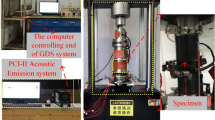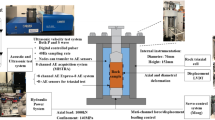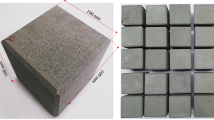Abstract
Under prolonged stress conditions, the tunnel surrounding rock produces a time-varying mechanical response, which poses a serious threat to the life cycle of the tunnel project. In this paper, a series of uniaxial compression tests were carried out on tunnel sandstone from Jiulongpo District using a self-developed rock servo instrument and acoustic emission (AE) testing system. Then, based on the theory of asymptotic damage evolution behaviour, different stress levels were set and multi-stage creep tests were conducted. The results show that the sandstone creep only exhibits a decelerated creep phase and a stabilised creep phase at the first three stress levels, while the accelerated creep phase is extremely obvious at the fourth stress level. The total number of acoustic emission events and total energy remained relatively constant in the stable creep stage, increased slightly in the decelerated creep stage, and increased significantly in the accelerated creep stage, and the distribution characteristics of the absolute energy of acoustic emission in different creep stages differed significantly. The probability density algorithm of the RA-AF scatterplot indicated that tensile cracks accounted for a larger proportion than shear cracks during the whole creep process. Finally, the constant parameters in the Burgers model were replaced by power-law functions with time-varying characteristics, and a nonlinear viscoplastic unit was introduced into the Burgers model to construct a nonlinear creep constitutive model that can describe the whole creep stage and has time-varying characteristics. The new model can quantitatively describe and predict the whole process of sandstone creep with high accuracy. The results are of great significance for monitoring and predicting the time-varying characteristics of tunnels and understanding the microscopic damage of sandstone.




















Similar content being viewed by others
Data availability
The data that support the findings of this study are available if needed. The website of this article is https://doi.org/10.1007/s12665-023-11329-9.
References
Amann F, Button EA, Evans KF, Gischig VS, Blümel M (2011) Experimental study of the brittle behavior of clay shale in rapid unconfined compression. Rock Mech Rock Eng 44(4):415–430
Aydan O, Ito T, Ozbay U, Kwasniews M, Shariar K, Okuno T et al (2014) ISRM Suggested Methods for Determining the Creep Characteristics of Rock. Rock Mech Rock Eng 47(1):275–290
Bieniawski ZT (2016) Mechanism of brittle fracture of rock: part part II—experimental studies. Int J Rock Mech Min Sci Geomech Abstr 4(4):407–423
Brantut N, Heap M, Meredith PG, Baud P (2013) Time-dependent cracking and brittle creep in crustal rocks: A review. J Struct Geol 52:17–43
Bykov DL, Martynova ED, Mel’nikov VP (2016) Numerical-Graphical Method for Describing the Creep of Damaged Highly Filled Polymer Materials. Mech Solids 50(5):571–577
Cai M, Kaiser PK, Tasaka Y, Maejima T, Morioka H, Minami M (2004) Generalized crack initiation and crack damage stress thresholds of brittle rock masses near underground excavations. Int J Rock Mech Min Sci 41(5):833–847
Cheng LC, Xu J, Peng SJ, Liu YX, Chen G, Li XW, Qin YL (2019) Mesoscopic Crack Initiation, Propagation, and Coalescence Mechanisms of Coal Under Shear Loading. Rock Mech Rock Eng 52(6):1979–1992
Cornelius RR, Scott PA (1993) A materials failure relation of accelerating creep as empirical description of damage accumulation. Rock Mech Rock Eng 26(3):233–252
Dong LJ, Zhang YH, Bi SJ, Ma J, Yan YH, Cao H (2023) Uncertainty investigation for the classification of rock micro-fracture types using acoustic emission parameters. Int J Rock Mech Min Sci 162:105292
Eberhardt E, Stead D, Stimpson B (1999) Quantifying progressive pre-peak brittle fracture damage in rockduring uniaxial compression. Int J Rock Mech Min 36(3):361–380
Fujii Y, Kiyama T, Ishijima Y, Kodama J (1999) Circumferential strain behavior during creep tests of brittle rocks. Int J Rock Mech Min 36(3):323–337
Gray V, Whittaker M (2015) Development and Assessment of a New Empirical Model for Predicting Full Creep Curves. Materials 8(7):4582–4592
Hamza O, Stace R (2018) Creep properties of intact and fractured muddy siltstone. Int J Rock Mech Min 106:109–116
Hobbs DW (1970) The behavior of broken rock under triaxial compression. Int J Rock Mech Min 7(2):125–148
Innocente JC, Paraskevopoulou C, Diederichs MS (2021) Estimating the long-term strength and time-to-failure of brittle rocks from laboratory testing. Int J Rock Mech Min 147:104900
Iyare UC, Blake OO, Ramsook R (2021) Estimating the Uniaxial Compressive Strength of Argillites Using Brazilian Tensile Strength, Ultrasonic Wave Velocities, and Elastic Properties. Rock Mech Rock Eng 54(4):2067–2078
Jaiswal AK, Yadawa PK, Yadav RR (2018) Ultrasonic wave propagation in ternary intermetallic CeCuGe compound. Ultrasonics 89:22–25
Kachanov M (1985) A simple technique of stress analysis in elastic solids with many cracks. Int J Fracture 28(1):R11–R19
Katicha SW, Flintsch GW (2012) Fractional viscoelastic models: master curve construction, interconversion, and numerical approximation. Rheol Acta 51(8):675–689
Kim JS, Lee KS, Cho WJ, Choi HJ, Cho GC (2015) A Comparative Evaluation of Stress-Strain and Acoustic Emission Methods for Quantitative Damage Assessments of Brittle Rock. Rock Mech Rock Eng 48(2):495–508
Kong R, Feng X-T, Zhang X, Yang C (2018) Study on crack initiation and damage stress in sandstone under true triaxial compression. Int J Rock Mech Min Sci 106:117–123
Lei X, Qin S, Sun Q, Wang Y, Lee LM, Li W (2014) A study on crack damage stress thresholds of different rock types based on uniaxial compression tests. Rock Mech Rock Eng 47(4):1183–1195
Li XF, Yin ZX (2021) Study of Creep Mechanical Properties and a Rheological Model of Sandstone under Disturbance Loads. Processes 9(8):1291
Li CB, Xie HP, Wang J (2020) Anisotropic characteristics of crack initiation and crack damage thresholds for shale. Int J Rock Mech Min 126:104178
Li GH, Wang YT, Wang D, Yang XX, Wang LG, Li YF et al (2021) Creep damage model of rock with varying-parameter under the step loading and unloading conditions. Sci Rep-UK 11(1):24057
Lin H, Zhang X, Cao RH, Wen ZJ (2020) Improved nonlinear Burgers shear creep model based on the time-dependent shear strength for rock. Environ Earth Sci 79(6):149
Liu L, Li H, Li X, Zhou C, Zhang G (2021) Simulation on heterogeneous rocks with a flaw using grain-based discrete-element method. Geotech Lett 11(1):56–65
Liu WT, Pang LF, Wu Q, Liu SQ, Shen JJ (2022) Research on the Damage Evolution of the Confined Water Floor Cracks in the Deep Stope Based on the Macro-Micro Study. Rock Mech Rock Eng 55(8):5029–5045
Ma YK, Yao QC, Wang JH, Sun S, Qiu ZL (2022) Time-Dependent Creep Constitutive Model of Roadway Surrounding Rock Based on Creep Parameters. Geofluids 2022:7981192
Maranini E, Brignoli M (1999) Creep behavior of a weak rock: Experimental characterization. Int J Rock Mech Min 36(1):127–138
Martin C, Chandler N (1994) The progressive fracture of Lac du Bonnet granite. Int J Rock Mech Min Sci Geomech Abstr 31(6):643–659
Meng QB, Zhang MW, Han LJ, Pu H, Chen YL (2018) Acoustic Emission Characteristics of Red Sandstone Specimens Under Uniaxial Cyclic Loading and Unloading Compression. Rock Mech Rock Eng 51(4):969–988
Murakami S, Ohno N (1982) A Constitutive Equation of Creep Based on the Concept of a Creep- Hardening Surface. Int J Solids Struct 18(7):597–609
Nicksiar M, Martin CD (2012) Evaluation of Methods for Determining Crack Initiation in Compression Tests on Low-Porosity Rocks. Rock Mech Rock Eng 45(4):607–617
Ohno K, Ohtsu M (2010) Crack classification in concrete based on acoustic emission. Constr Build Mater 24(12):2339–2346
Rabotnov YuN, Kh Papernik L, Stepanychev EI (1973) Description of creep of composition materials under tension and compression. Polym Mech 9:690–695
Shi ZM, Li JT, Wang J (2022) Effect of the upper limit stress on the fatigue properties and crack propagation processes of sandstones containing pre-existing crack under fatigue-creep interaction. Fatigue Fract Eng M 45(5):1391–1405
Sone H, Zoback MD (2014) Time-dependent deformation of shale gas reservoir rocks and its long-term effect on the in situ state of stress. Int J Rock Mech Min 69:120–132
Song XD, Ren JH (2012) A Constitutive Model for the Creep Behavior of Offwhite Marbles. Adv Appl Math Mech 4(3):354–364
Sun TG, Fu HL (2022) Rheological Analysis of Soft Rock Unloading Combined with Finite Element Analysis Based on H-K Constitutive Model. Math Probl Eng 2022:8949590
Sun H, Du WS, Liu C (2021) Uniaxial Compressive Strength Determination of Rocks Using X-ray Computed Tomography and Convolutional Neural Networks. Rock Mech Rock Eng 54(8):4225–4237
Tsai LS, Hsieh YM, Weng MC, Huang TH, Jeng FS (2008) Time-dependent deformation behaviors of weak sandstones. Int J Rock Mech Min 45(2):144–154
Voight B (1998) A method for prediction of volcanic eruptions. Nature 332(6160):125–130
Wiederhorn SM, Dretzke A, Rodel J (2002) Crack Growth in Soda-Lime-Silicate Glass near the Asymptotic damage evolution behavior. J Am Ceram Soc 85(9):2287–2292
Wu F, Liu JF, Wang J (2015) An improved Maxwell creep model for rock based on variable-order fractional derivatives. Environ Earth Sci 73(11):6965–6971
Wu F, Zhou XH, Ying P, Li C, Zhu ZM, Chen J (2022a) A Study of Uniaxial Acoustic Emission Creep of Salt Rock Based on Improved Fractional-Order Derivative. Rock Mech Rock Eng 55(3):1619–1631
Wu K, Shao ZS, Qin S, Zhao NN, Chu ZF (2022b) An Improved Nonlinear Creep Model for Rock Applied to Tunnel Displacement Prediction. Int J Appl Mech 13(8):2150094
Wu F, Ji CX, Liu J, Gao RB, Li CB, Zou QL, Chen J (2023) Study on visco-elastoplastic fractional creep model of surrounding rock of salt cavern gas storage. J Energy Storage 67:107606
Xiong LX, Li TB, Yang LD, Yuan XW (2015) A study on stationary and nonstationary viscoelastic models of greenschist. Arab J Geosci 8(5):2477–2486
Xue L, Qin S, Sun Q, Wang Y, Lee LM, Li W (2014) A study on crack damage stress thresholds of different rock types based on uniaxial compression tests. Rock Mech Rock Eng 47:1183–1195
Yang J, Zhao K, Yu K, Yan YJ, He ZW, Lai YM et al (2022) Crack classification of fiber-reinforced backfill based on Gaussian mixed moving average filtering method. Cement Concrete Comp 134:104740
Ye CF, Xie HP, Wu F, Li CB. Nonlinear creep properties and time-to-failure prediction of sandstone under saturated and dry conditions. Environ Earth Sci 81(24):545
Yoon YS, Lee SK, Lee MS, Kim JK, Kwon KY (2011) Rheological concrete creep prediction model for prestressed concrete bridges constructed by the free cantilever method. MAG Concrete Res 63(9):645–653
Zha E, Zhang Z, Zhang R, Wu SY, Li CB, Ren L, Gao MZ et al (2021) Long-term mechanical and acoustic emission characteristics of creep in deeply buried jinping marble considering excavation disturbance. Int J Rock Mech Min 139:104603
Zhai MY, Xu C, Xue L, Cui Y, Dong JY (2022) Loading Rate Dependence of Staged Damage Behaviors of Granite under Uniaxial Compression: Insights from Acoustic Emission Characteristics. Theor Appl Fract Mec 122:103633
Zhang JW (2017) Effects of Anisotropy for P-Wave Velocity on Locating Accuracy of Acoustic Emission Sources in Sandstone. IEEE Access 5:18132–18142
Zhang L, Liu YR, Yang Q (2016) Study on time-dependent behavior and stability assessment of deep-buried tunnels based on internal state variable theory. Tunn Undergr SP Tech 51:164–174
Zhang FR, Jiang AN, Yang XR (2021) Shear creep experiments and modeling of granite under dry-wet cycling. B Eng Geol Environ 80(7):5897–5908
Zhao XG, Cai M, Wang J, Ma LK (2013) Damage stress and acoustic emission characteristics of the Beishan granite. Int J Rock Mech Min Sci 64:258–269
Zhou HW, Liu D, Lei G, Xue DJ, Zhao Y (2018) The Creep-Damage Model of Salt Rock Based on Fractional Derivative. Energies 11(9):2349
Zhou C, Yu L, You F, Liu Z, Zhang L (2020) Coupled Seepage and Stress Model and ExperimentVerification for Creep Behavior of Soft Rock. Int J Geomech 20(9):04020146
Zhou XP, Pan XK, Berto F (2022a) A state-of-the-art review on creep damage mechanics of rocks. Fatigue Fract Eng M 45(3):627–652
Zhou XP, Jiang DC, Zhao Z (2022b) Digital Evaluation of Micro-Pore Water Effects on Mechanical and Damage Characteristics of Sandstone Subjected to Uniaxial, Cyclic Loading-Unloading Compression by 3D Reconstruction Technique. Rock Mech Rock Eng 55(1):147–167
Zhu WC, Li SH, Li S, Niu LL (2019) Influence of Dynamic Disturbance on the Creep of Sandstone: An Experimental Study. Rock Mech Rock Eng 52(4):1023–1039
Zhuang XY, Zhou SW (2020) An Experimental and Numerical Study on the Influence of Filling Materials on Double-Crack Propagation. Rock Mech Rock Eng 53(12):5571–5591
Acknowledgements
The author(s) disclosed receipt of the following financial support for the research, authorship, and/or publication of this article: This work is supported by National Natural Science Foundation of China (52074043, 52022014, 52374078), Fundamental Research Funds for the Central Universities (2020CDJQY-A049), Chongqing Natural Science Foundation Project CSTB (2022NSCQ-MSX0914).
Funding
This work is supported by National Natural Science Foundation of China (52074043, 52022014, 52374078), Fundamental Research Funds for the Central Universities (2020CDJQY-A049), Chongqing Natural Science Foundation Project CSTB (2022NSCQ-MSX0914).
Author information
Authors and Affiliations
Contributions
SG: data curation, writing—original draft preparation. FW: conceptualization, methodology, writing—reviewing and editing. RG: supervision, inspection. CY: visualization, investigation.
Corresponding author
Ethics declarations
Conflict of interest
The authors declare no competing interests.
Additional information
Publisher's Note
Springer Nature remains neutral with regard to jurisdictional claims in published maps and institutional affiliations.
Rights and permissions
Springer Nature or its licensor (e.g. a society or other partner) holds exclusive rights to this article under a publishing agreement with the author(s) or other rightsholder(s); author self-archiving of the accepted manuscript version of this article is solely governed by the terms of such publishing agreement and applicable law.
About this article
Cite this article
Gao, S., Wu, F., Gao, R. et al. Multi-stepped creep constitutive model based on asymptotic damage evolution behavior of sandstone. Environ Earth Sci 83, 17 (2024). https://doi.org/10.1007/s12665-023-11329-9
Received:
Accepted:
Published:
DOI: https://doi.org/10.1007/s12665-023-11329-9




